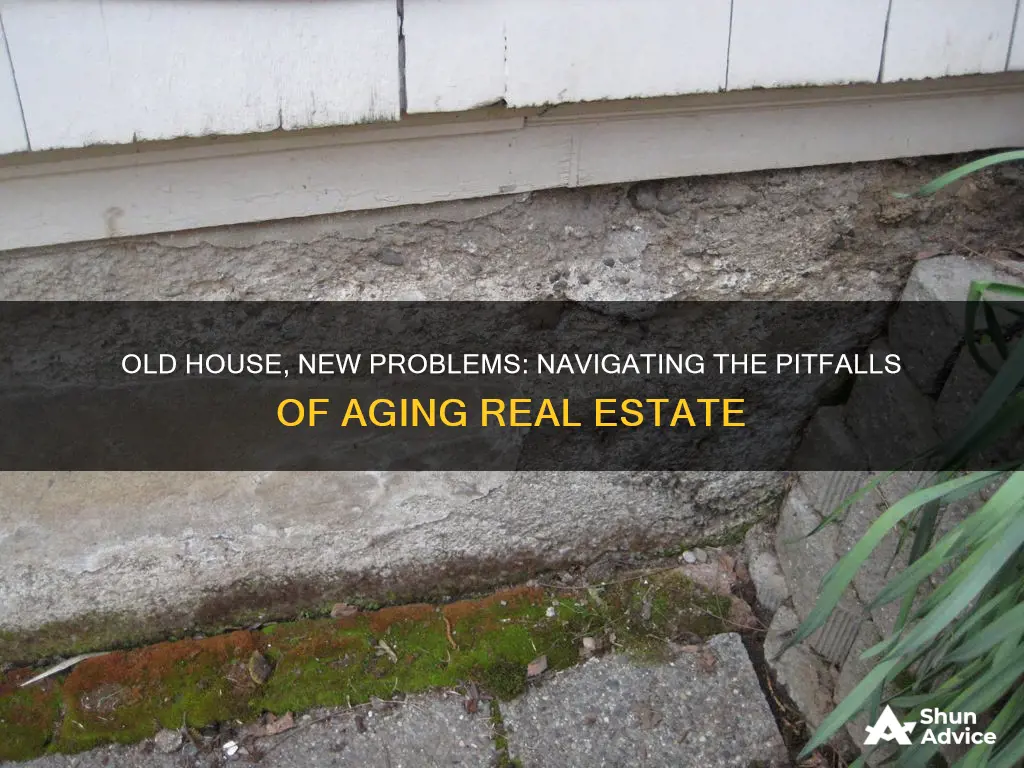
There are several factors to consider when deciding whether to invest in an old house. While older homes may have unique architectural styles, larger yards, and established locations, they also come with potential issues such as outdated electrical systems, plumbing problems, and higher maintenance costs. On the other hand, older homes are generally cheaper than new homes, have lower property taxes, and may have more square footage. Ultimately, investing in an old house can be a smart financial move, but it requires careful consideration and thorough inspection to ensure a profitable outcome.
| Characteristics | Values |
|---|---|
| Purchase Price | Older homes are cheaper than newer homes |
| Purchase History | Older homes have a longer purchase history, which can indicate the property's appreciation value over time |
| Location | Older homes are more likely to be in established, central locations |
| Architectural Style | Older homes have more architectural individuality and character |
| Landscaping | Older homes usually have larger yards with more mature landscaping |
| Building Materials | Older homes were built with more solid, long-lasting materials |
| Maintenance | Older homes require more frequent maintenance |
| Layout | Older homes have smaller, separate spaces |
| Energy Efficiency | Older homes are less energy efficient |
| Safety | Older homes may not be built to modern safety standards |
| Property Taxes | Older homes have lower property taxes |
What You'll Learn

Old houses are cheaper than new homes
Old houses are generally cheaper than new homes. Sellers and real estate agents determine home prices based on a variety of criteria, with the age of the home being a significant factor. The newer the home, the higher the cost. According to Rocket Mortgage, the cost of buying a new home is typically 30% higher than that of an older home.
However, it is important to note that older homes may require more maintenance and repairs, which can be costly. Before purchasing an older home, it is advisable to get a full home inspection to identify any potential issues, such as foundation problems, plumbing issues, or outdated electrical systems.
Older homes also tend to have higher utility costs due to less stringent building codes and less energy-efficient designs. A study by the Energy Information Administration (EIA) found that heating a newer home is 21% cheaper, even if it is larger than an older home in the same area.
Despite the potential for higher maintenance and utility costs, older homes can still be a more economical choice, depending on their sale price, location, and age. They are often located in well-established neighbourhoods, closer to city centres, and offer unique features such as mature landscaping and charm that cannot be duplicated.
In summary, while older homes may require more upkeep and have higher utility bills, they provide an opportunity for substantial savings upfront and the potential for a wise investment, depending on various factors.
Teaching Retirement: Navigating the Investment Maze
You may want to see also

Old homes have better-quality construction
Old homes are often built with higher-quality materials and craftsmanship, making them more durable and aesthetically pleasing.
Firstly, older homes were often constructed using wood from old-growth trees, which are more resistant to rot and warping. This is in contrast to newer homes, where wood may be engineered or composite, which may not be as long-lasting. Old-growth wood also lends a sense of solidity and heft to features like doors and hardwood floors.
Secondly, the walls in older homes are typically built with plaster and lathe, making them structurally stronger than the drywall construction commonly found in modern homes. These older materials also tend to provide better sound insulation.
Additionally, older homes often feature unique architectural details and designs that are challenging to replicate in modern construction. For example, original crown moulding, herringbone-patterned hardwood floors, and built-in bookcases with matching arches on the doorways. These features add character and charm, reflecting the styles and trends of bygone eras.
Furthermore, the construction techniques and materials used in older homes cannot always be reproduced today. For instance, the dimensions of wooden beams and joists used in older homes tend to be larger and sturdier than those used in modern construction. This over-engineering contributes to the overall durability and longevity of older homes.
While older homes may require updates to electrical, plumbing, and insulation systems, the fundamental construction and materials often exhibit superior quality and craftsmanship compared to newer homes.
Rethink Robotics: Investors' Vision
You may want to see also

Old homes are often in established locations
When considering buying an old house, it is important to weigh the pros and cons. One of the main advantages of purchasing an older home is that it is often situated in an established location. This means that the neighbourhood is likely to be well-developed, with a sense of community and a lower possibility of zoning changes. Such areas are usually centrally located, closer to downtown, and have larger yards with mature landscaping, which can increase the value of the property.
Old houses are often situated in stable, well-established areas. These neighbourhoods have had time to develop and grow, and often benefit from a strong sense of community. The locations are typically central, with convenient access to downtown areas. This established nature also means that zoning changes are less likely to occur, providing a sense of stability for residents.
The mature landscaping in these neighbourhoods is another appealing feature. The vegetation has had time to grow and flourish over the years, adding to the aesthetic appeal of the area. This greenery not only enhances the emotional well-being of residents but also contributes to an increase in property values.
In addition to the established locations, old homes often offer unique architectural styles and craftsmanship that are hard to find in modern constructions. They possess a certain charm and individuality that many buyers find appealing. The attention to detail and commitment to architectural individuality in older homes can be a significant draw for prospective buyers.
Furthermore, older homes are often situated in areas with a rich history. They may hold historical significance within their respective towns, adding to their allure. For those interested in the history of the area, purchasing an old home can provide a deeper connection to the community and a sense of pride in owning a piece of local history.
When considering the location of an old home, it is worth noting that these properties are often centrally located within cities. This centrality can be a significant advantage for those looking to live in close proximity to downtown areas, offering shorter commutes and easier access to various amenities and attractions.
UPRO: Why Investors Are Not Buying
You may want to see also

Old homes have more character
Old homes have a unique character and charm that newer builds often lack. This charm can come from the history of the house, the area it's in, or the features it has.
Older homes are more likely to have unique features that reflect the era in which they were built. For example, original crown moulding, herringbone-patterned hardwood floors, and built-in features. Some older homes have mature trees in the front yard, which can add to their curb appeal.
The character of an older home can also be found in its construction. Older homes were often built with higher-quality materials, such as wood from old-growth trees, which is more resistant to rot and warping. The walls of older homes are also likely to be different from those of modern homes. For example, they might be made with plaster and lathe, making them structurally stronger than drywall. These older materials can also provide better sound insulation.
In addition, older homes are often located in well-established areas, which can add to their character and appeal.
Investing: Nice People, Psychopaths?
You may want to see also

Old homes have higher maintenance costs
Old homes are bound to have higher maintenance costs. A study from the American Housing Survey (AHS) found that people who own older homes pay more for regular maintenance than owners of newly built houses. Of all homeowners, 26 percent paid more than $100 a month in maintenance costs. However, only 11 percent of owners who live in newly constructed homes paid that much.
The initial costs of upkeep are higher for new owners of older homes than for those who have lived in their homes for at least 10 years. About 61% of owners of older homes started a home improvement project between 2019 and 2021, spending a median of $4,100 on all their home improvement projects during that time.
The median annual spending on maintenance alone was around $540 for owners of older homes. Owners of older homes who had moved in within the past two years tended to spend more on overall upkeep. These new owners spent a median of $3,900 per year, while longtime owners who had lived in older homes for at least 10 years spent about $1,500 annually.
Owners of older homes spent a median of $200 per 500 square feet of living space on routine maintenance annually. Those who undertook at least one home improvement project spent a median of about $700 for each 500 square feet of living space on their projects.
Newer homes are built with different materials such as energy-efficient products that drive up the cost of building them and, by extension, the cost of buying them. Older homes, on the other hand, are likely to have outdated electrical systems, plumbing, and insulation.
Older homes are also more likely to have hazardous materials such as lead and asbestos. If the home was built before 1978, it may contain lead paint and asbestos insulation. Removing asbestos can be expensive, costing between $20,000 and $30,000 for a whole-house removal.
Another factor to consider is the cost of insurance. Older homes are constructed under less strict safety codes, making them more expensive to insure. The average cost of property insurance per square foot can be nearly a quarter lower for new homes than for those 40 years old or older.
Helium Havens: Navigating the Investment Landscape
You may want to see also
Frequently asked questions
Older houses are cheaper than newer homes, have better-quality construction, are often in established locations, and have more character.
Older houses may have structural or foundational problems, hazardous materials, outdated electrical systems, and inefficient windows.
Some potential issues to watch out for include major cracks or unevenness in the foundation, corrosion or moisture damage in concrete supports, damaged support footings, doors that jam or won't latch, windows that get stuck, outdated electrical wiring, and inefficient windows that cause higher utility bills.
Buying an old house can be a good investment if you are aware of the potential issues and are prepared to address them. Older houses often have lower purchase prices and property taxes, more square footage, and more solid building materials. However, they may require significant renovations and upgrades, which can be costly.







